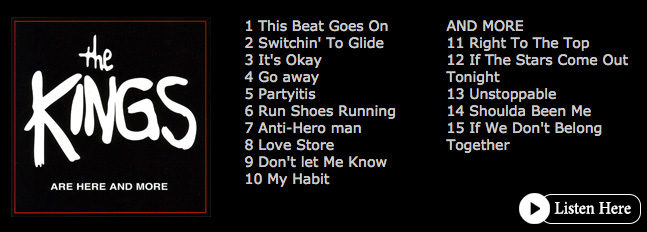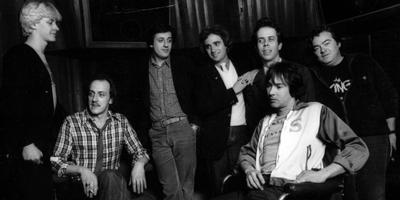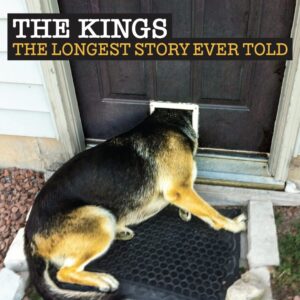 When Bob Ezrin walked into Nimbus 9 Studio in Yorkville, Toronto one day he had no idea what we was walking into.He was taking some time off after the completion of Pink Floyd’s The Wall which had taken more than a year. He was back home in Toronto and dropped into the studio where he had worked with Alice Cooper and others to hang out and watch some football and see friends like Jack Richardson who still did work out of Nimbus.Little did he know that he would soon be at it again with an unknown band called The Kings.
When Bob Ezrin walked into Nimbus 9 Studio in Yorkville, Toronto one day he had no idea what we was walking into.He was taking some time off after the completion of Pink Floyd’s The Wall which had taken more than a year. He was back home in Toronto and dropped into the studio where he had worked with Alice Cooper and others to hang out and watch some football and see friends like Jack Richardson who still did work out of Nimbus.Little did he know that he would soon be at it again with an unknown band called The Kings.
At this point in time The Kings had already been playing together for more than three years under the name WhistleKing and were trying to work as much original material into their live club shows as possible.The focus was always on writing which had led the band to winning the first ever Home-Grown talent contest in Toronto radio history over more than six hundred other contestants.
The music business in Canada at the time was still in its infancy however and all The Kings got out of their victory was a free lunch!
By the way the name of the song that won that contest was “Turn My Face” which later evolved into “Don’t Let Me Know” That radio contest did bring forth more than a couple of people who wanted to help the band and so WhistleKing kept writing while deciding what path to follow.
At this point in time the band had started to grow away from the more complex songs in their repetoire and started thinking about something else; WRITING HITS.
Its not that the boys of WhistleKing were trying to not write hits it was more a case of the bottom falling out of the kind of long involved arrangements they were into.The reason was simple enough and the reason was a thing called punk.
The rise of the punk movement was no big threat to WhistleKing except that the band was trying to be good musicians whereas the whole philosophy behind punk was that rock and roll was about attitude more than ability.But as far as being able to rock out at high volume levels that was old hat for these guys.
Then came the marketing ploy known as “New Wave”. Somewhere, somehow the nastiness of punk had to be toned down and made accessible to the record buying public.This brought forth bands that had attitude and hits with a different sound than the disco, prog-rock and country-rock bands of the 70’s which was what punk was against in the first place.
So now we have people asking instead of that hard to remember WhistleKing, where are The Kings playing? And so in the spirit of the times the guys all got stage names and started working on what would become The Kings ARE HERE.
The Kings were still doing lots of club shows and did about 50-50 covers and originals. Doing six nighters in one place was good for the band because they could rehearse during the day and play and write at night.The songs got shorter and The Kings got tighter.They had a high energy live show that did well in the clubs and they had lots of gigs.But… they wanted to make a record and they had an albums worth of new songs including two weird ones that they stuck together.
Somehow they found enough money to start recording at Nimbus 9 studio in Toronto.The album was just about done when Bob Ezrin came visiting. He liked what was happening and agreed to mix those two songs that went together called This Beat Goes On/Switchin’ to Glide. What he found out as he tore the tracks apart was that although the band was loaded with good ideas they didn’t know anything about making records, real records.And he just happened to be the top producer in the world! So he said “look, you have what it takes but we gotta re-do this whole thing because your parts and tempos are all over the place. Let me see what I can do.” And just like out of a story book he took the tapes to L.A. and Ken Buttice at Elektra Records loved the tunes and got out the contract. And that is how it started for The Kings.
So what happened next was pretty much a dream come true for a young band, a major label deal in America, a top producer and a budget to do things right.
 Remember that Ezrin came in as The Kings were getting near the end of recording that indie album, now they had to re-rehearse and re-record the whole thing! It was a great learning experience for the band.A whole MONTH of rehearsal where every song and part was broken down and revamped. Some songs were re-written. If you heard the original version of This Beat Goes On you would be amazed. One of Ezrin’s techniques was to hear the song in a simple form and when he heard something he didn’t like he’d yell stop and it was fix it time. That is what happened with This Beat Goes On. It was a simpler chord structure that was not as hooky with lyrics that were not as direct. David Diamond understood what Ezrin was getting at regarding the chords and went and changed the parts so that although more complicated musically, it sounded better and was way more catchy. That is when Zero re-wrote the lyrics to the B-verse which is where all this improvement was taking place so instead of the original “Lots of dusty mentals can be blown at any time…” we now have “I have lots of friends that I can ding at any time…” It’s pretty obvious which is better and there was more than just that example. Indeed, the whole thing was worked on with the same attitude, “what can we do to make this better?” Dave and Max would get left in the rehearsal room for hours “drilling”, going over and over and over their rhythm section parts until they were rock solid.
Remember that Ezrin came in as The Kings were getting near the end of recording that indie album, now they had to re-rehearse and re-record the whole thing! It was a great learning experience for the band.A whole MONTH of rehearsal where every song and part was broken down and revamped. Some songs were re-written. If you heard the original version of This Beat Goes On you would be amazed. One of Ezrin’s techniques was to hear the song in a simple form and when he heard something he didn’t like he’d yell stop and it was fix it time. That is what happened with This Beat Goes On. It was a simpler chord structure that was not as hooky with lyrics that were not as direct. David Diamond understood what Ezrin was getting at regarding the chords and went and changed the parts so that although more complicated musically, it sounded better and was way more catchy. That is when Zero re-wrote the lyrics to the B-verse which is where all this improvement was taking place so instead of the original “Lots of dusty mentals can be blown at any time…” we now have “I have lots of friends that I can ding at any time…” It’s pretty obvious which is better and there was more than just that example. Indeed, the whole thing was worked on with the same attitude, “what can we do to make this better?” Dave and Max would get left in the rehearsal room for hours “drilling”, going over and over and over their rhythm section parts until they were rock solid.
Finally the recording began and this was done back at Nimbus 9 which was in a lovely part of Toronto called Yorkville. This was great because during the breaks the band could go out and look at all the pretty girls walking around. Some of these were pulled in off the street for the “Party Scene” in the song Partyitis. Some mics were placed in the office part of the studio and the band got some booze and had a party! Ezrin didn’t think it was loud enough so in order to get more response he streaked the party! More than once! Six weeks later the songs were ready to mix and Ezrin went to his favorite place for mixing which was Producers Workshop in Hollywood California. The results speak for themselves and everyone was very excited about the future. In The Kings minds This Beat and Switchin’ were always supposed to be together as a segue. They were not too happy when Elektra Records decided to release Switchin’ on its own. It did get some play but finally after pressure from the band the segue was released and it was only then that radio really picked up on it. Key markets included Chicago and the mid-west, Texas, California and all down the eastern seaboard. The Beat/Switchin’ combo stayed on the Billboard chart for twenty six weeks as it broke in different markets.
The Kings were also excited about the second single Don’t Let Me Know which Diamond wrote on his own. This was the song that had won a Home-Grown radio contest and finally after being recorded four or five different times was ready to go. If you read the book Hit Men you will get an understanding of what the climate was like in the record business at the time. Although not mentioned by name The Kings were very much a victim of the politics between the indie promotion world and the record companies. As a result Don’t Let Me Know did not realize its potential and it was time to start thinking about the next studio album.
AND MORE….
As the years went past The Kings kept hearing one phrase over and over; “When are we gonna be able to get The Kings Are Here on CD?” Well, it wasn’t like the band were trying to keep it hidden, it was that no-one would put it out! Many efforts were made over time and they all turned out negative. Mister Zero talked with people at the parent company and different indie labels throughout North America on many occasions and when it seemed like someone might be interested the cost of getting all the proper licenses made the idea impossible.
According to the bookkeepers The Kings owe a whole lot of U.S. dollars to Elektra and any money made goes to pay down that debt. All this is more fallout from Amazon Beach, of course. It cost as much to make as Are Here only it tanked sales wise. This is business, no problem there but how can the money be paid if the product does not exist? All that was able to happen was the addition of This Beat Goes On/Switchin’ to Glide to the Unstoppable package which at least got the “hit” out there but other financial problems buried that great album too.
But, as we have said before, the people still wanted it and radio kept playing it so The Kings had to keep trying. One day early in 1999, on a tip given by a friend Zero contacted Mr. Alan Fletcher at Warner Canada. Other attempts had ended up empty handed but Alan is in charge of Strategic Projects, something that Zero had never heard of. One of the weird things about the music business is that no matter how many times you hear the word “NO” someday you may reach someone who says “YES” and that is what happened. After listening to the pitch Alan said “Sounds like a good idea, let’s do it, but since you owe us so much money and we don’t have to give you a dime let alone ask permission to do this re-release, why don’t you put five new songs on it and we’ll have to license them from you and that way you can see some cash.”
Well you gotta love a guy like that and that is how the bonus tracks came to be on The Kings Are Here And More. But what songs to use? Since Unstoppable was out of print it was decided to put three of the best from it: Unstoppable (a Kingsy rocker that went Top 10 on the Canadian charts), If We Don’t Belong Together (a Keyes-Zero ballad that got lots of airplay on Adult Contemporary stations and is some folks favorite Kings tune) and Shoulda Been Me (which in the bands minds was and always will be a hit even though it did not do that great at radio). Shoulda Been Me was also reworked and remixed for this project.
Diamond and Zero also had a couple of brand new tunes that were supposed to be in demo form but sounded good enough to put out so they were added as well. These two, Right To The Top (a rocker that’s for sure) and If The Stars Come Out Tonight (a heavy ballad that is a super song) show that D and Z have not lost anything writing wise and Diamond’s voice is as powerful as ever. One other very important thing also had to be dealt with and that is the tracks from Are Here. The band felt strongly that it was not enough to do a straight tape transfer. Fortunately Warner had an original two-track master of the album and with a little coaxing were convinced that a total re-mastering was a good idea.
Zero oversaw this process at MusicLane with Ted Carson and the result is very impressive. One fan in Philadelphia was amazed when he heard Beat/Switchin’. He heard things he never knew were there! It is also as loud as it can be technically. All you radio people should get your local Warner rep to get you a freebee! So that is how The Kings came to be back with Warner and although the album is in effect a catalog item, the full distribution muscle is there and as anyone in the biz will tell you, that is more than half the battle. It is available in stores throughout Canada and some in the U.S. have imported it as well. It can also be bought on the net through this web-site. It makes a great gift as well!


